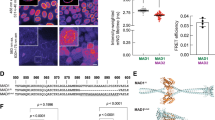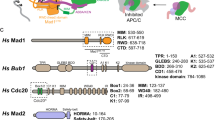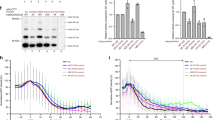Abstract
The spindle checkpoint delays chromosome segregation in response to misaligned sister chromatids during mitosis, thus ensuring the fidelity of chromosome inheritance. Through binding to Cdc20, the Mad2 spindle checkpoint protein inhibits the target of this checkpoint, the ubiquitin protein ligase APC/CCdc20. We now show that without cofactor binding or covalent modification Mad2 adopts two distinct folded conformations at equilibrium (termed N1-Mad2 and N2-Mad2). The structure of N2-Mad2 has been determined by NMR spectroscopy. N2-Mad2 is much more potent in APC/C inhibition. Overexpression of a Mad2 mutant that specifically sequesters N2-Mad2 partially blocks checkpoint signaling in living cells. The two Mad2 conformers interconvert slowly in vitro, but interconversion is accelerated by a fragment of Mad1, an upstream regulator of Mad2. Our results suggest that the unusual two-state behavior of Mad2 is critical for spindle checkpoint signaling.
This is a preview of subscription content, access via your institution
Access options
Subscribe to this journal
Receive 12 print issues and online access
$189.00 per year
only $15.75 per issue
Buy this article
- Purchase on Springer Link
- Instant access to full article PDF
Prices may be subject to local taxes which are calculated during checkout






Similar content being viewed by others
Accession codes
References
Nasmyth, K. Segregating sister genomes: the molecular biology of chromosome separation. Science 297, 559–565 (2002).
Cleveland, D.W., Mao, Y. & Sullivan, K.F. Centromeres and kinetochores. From epigenetics to mitotic checkpoint signaling. Cell 112, 407–421 (2003).
Yu, H. Regulation of APC-Cdc20 by the spindle checkpoint. Curr. Opin. Cell Biol. 14, 706–714 (2002).
Shah, J.V. & Cleveland, D.W. Waiting for anaphase: Mad2 and the spindle assembly checkpoint. Cell 103, 997–1000 (2000).
Tang, Z., Bharadwaj, R., Li, B. & Yu, H. Mad2-independent inhibition of APCCdc20 by the mitotic checkpoint protein BubR1. Dev. Cell 1, 227–237 (2001).
Sudakin, V., Chan, G.K. & Yen, T.J. Checkpoint inhibition of the APC/C in HeLa cells is mediated by a complex of BUBR1, BUB3, CDC20, and MAD2. J. Cell Biol. 154, 925–936 (2001).
Fang, G. Checkpoint protein BubR1 acts synergistically with Mad2 to inhibit anaphase-promoting complex. Mol. Biol. Cell 13, 755–766 (2002).
Chen, R.H. BubR1 is essential for kinetochore localization of other spindle checkpoint proteins and its phosphorylation requires Mad1. J. Cell Biol. 158, 487–496 (2002).
Millband, D.N. & Hardwick, K.G. Fission yeast Mad3p is required for Mad2p to inhibit the anaphase-promoting complex and localizes to kinetochores in a Bub1p-, Bub3p-, and Mph1p-dependent manner. Mol. Cell. Biol. 22, 2728–2742 (2002).
Chen, R.H., Brady, D.M., Smith, D., Murray, A.W. & Hardwick, K.G. The spindle checkpoint of budding yeast depends on a tight complex between the Mad1 and Mad2 proteins. Mol. Biol. Cell 10, 2607–2618 (1999).
Luo, X., Tang, Z., Rizo, J. & Yu, H. The Mad2 spindle checkpoint protein undergoes similar major conformational changes upon binding to either Mad1 or Cdc20. Mol. Cell 9, 59–71 (2002).
Chung, E. & Chen, R.H. Spindle checkpoint requires Mad1-bound and Mad1-free Mad2. Mol. Biol. Cell 13, 1501–1511 (2002).
Habu, T., Kim, S.H., Weinstein, J. & Matsumoto, T. Identification of a MAD2-binding protein, CMT2, and its role in mitosis. EMBO J. 21, 6419–6428 (2002).
Wassmann, K., Liberal, V. & Benezra, R. Mad2 phosphorylation regulates its association with Mad1 and the APC/C. EMBO J. 22, 797–806 (2003).
Sironi, L. et al. Crystal structure of the tetrameric Mad1-Mad2 core complex: implications of a 'safety belt' binding mechanism for the spindle checkpoint. EMBO J. 21, 2496–2506 (2002).
Luo, X. et al. Structure of the Mad2 spindle assembly checkpoint protein and its interaction with Cdc20. Nat. Struct. Biol. 7, 224–229 (2000).
Musacchio, A. & Hardwick, K.G. The spindle checkpoint: structural insights into dynamic signaling. Nat. Rev. Mol. Cell Biol. 3, 731–741 (2002).
Sironi, L. et al. Mad2 binding to Mad1 and Cdc20, rather than oligomerization, is required for the spindle checkpoint. EMBO J. 20, 6371–6382 (2001).
Fang, G., Yu, H. & Kirschner, M.W. The checkpoint protein MAD2 and the mitotic regulator CDC20 form a ternary complex with the anaphase-promoting complex to control anaphase initiation. Genes Dev. 12, 1871–1883 (1998).
Canman, J.C., Salmon, E.D. & Fang, G. Inducing precocious anaphase in cultured mammalian cells. Cell Motil. Cytoskeleton 52, 61–65 (2002).
Altmann, F., Staudacher, E., Wilson, I.B. & Marz, L. Insect cells as hosts for the expression of recombinant glycoproteins. Glycoconj. J. 16, 109–123 (1999).
Dhalluin, C. et al. Structural basis of SNT PTB domain interactions with distinct neurotrophic receptors. Mol. Cell 6, 921–929 (2000).
Bullough, P.A., Hughson, F.M., Skehel, J.J. & Wiley, D.C. Structure of influenza haemagglutinin at the pH of membrane fusion. Nature 371, 37–43 (1994).
Sauter, N.K., Mau, T., Rader, S.D. & Agard, D.A. Structure of α-lytic protease complexed with its pro region. Nat. Struct. Biol. 5, 945–950 (1998).
Barrientos, L.G. et al. The domain-swapped dimer of cyanovirin-N is in a metastable folded state: reconciliation of X-ray and NMR structures. Structure 10, 673–686 (2002).
Khazanovich, N., Bateman, K., Chernaia, M., Michalak, M. & James, M. Crystal structure of the yeast cell-cycle control protein, p13suc1, in a strand-exchanged dimer. Structure 4, 299–309 (1996).
Ye, S. & Goldsmith, E.J. Serpins and other covalent protease inhibitors. Curr. Opin. Struct. Biol. 11, 740–745 (2001).
Volkman, B.F., Lipson, D., Wemmer, D.E. & Kern, D. Two-state allosteric behavior in a single-domain signaling protein. Science 291, 2429–2433 (2001).
James, L.C., Roversi, P. & Tawfik, D.S. Antibody multispecificity mediated by conformational diversity. Science 299, 1362–1367 (2003).
Prusiner, S.B. Prions. Proc. Natl. Acad. Sci. USA 95, 13363–13383 (1998).
Mottonen, J. et al. Structural basis of latency in plasminogen activator inhibitor-1. Nature 355, 270–273 (1992).
Howell, B.J., Hoffman, D.B., Fang, G., Murray, A.W. & Salmon, E.D. Visualization of Mad2 dynamics at kinetochores, along spindle fibers, and at spindle poles in living cells. J. Cell Biol. 150, 1233–1250 (2000).
Hardwick, K.G., Weiss, E., Luca, F.C., Winey, M. & Murray, A.W. Activation of the budding yeast spindle assembly checkpoint without mitotic spindle disruption. Science 273, 953–956 (1996).
Seeley, T.W., Wang, L. & Zhen, J.Y. Phosphorylation of human MAD1 by the BUB1 kinase in vitro . Biochem. Biophys. Res. Commun. 257, 589–595 (1999).
Clore, G.M. & Gronenborn, A.M. NMR structure determination of proteins and protein complexes larger than 20 kDa. Curr. Opin. Chem. Biol. 2, 564–570 (1998).
Gardner, K.H. & Kay, L.E. The use of 2H, 13C, 15N multidimensional NMR to study the structure and dynamics of proteins. Annu. Rev. Biophys. Biomol. Struct. 27, 357–406 (1998).
Cornilescu, G., Delaglio, F. & Bax, A. Protein backbone angle restraints from searching a database for chemical shift and sequence homology. J. Biomol. NMR 13, 289–302 (1999).
Brünger, A.T. et al. Crystallography & NMR system: A new software suite for macromolecular structure determination. Acta Crystallogr. D 54, 905–921 (1998).
Elbashir, S.M. et al. Duplexes of 21-nucleotide RNAs mediate RNA interference in cultured mammalian cells. Nature 411, 494–498 (2001).
Kraulis, P.J. MOLSCRIPT: a program to produce both detailed and schematic plots of protein structures. J. Appl. Crystallogr. 24, 946–950 (1991).
Merritt, E.A. & Bacon, D.J. Raster3D: photorealistic molecular graphics. Methods Enzymol. 277, 505–524 (1997).
Kuzmic, P. Program DYNAFIT for the analysis of enzyme kinetic data: application to HIV Proteinase. Anal. Biochem. 237, 260–273 (1996).
Acknowledgements
We thank Y. Liu for reading the manuscript critically and R. Hampton for suggestions. This work was supported by the American Cancer Society (to X.L.), Association pour la Recherche contre le Cancer (ARC) (to K.W.), the Ministry of Education, Culture, Sports, Science and Technology of Japan (COE Research) (to T.M.), the Welch Foundation (to J.R. and H.Y.), the Packard Foundation (to H.Y.), the Burroughs Wellcome Fund (to H.Y.), the W.M. Keck Foundation (to H.Y.) and the US National Institutes of Health (to H.Y.).
Author information
Authors and Affiliations
Corresponding authors
Ethics declarations
Competing interests
The authors declare no competing financial interests.
Supplementary information
Supplementary Fig. 1
The HSQC spectrum of Mad2–MBP1 is more similar to N2-Mad2 R133A than to N1-Mad2 R133A.(a) The sum of 1H and 15N chemical shift differences (Min Δδ=(1HΔδ2 +( 15NΔδ*0.17)2)½)between N1-Mad2 R133A and Mad2–MBP1 is plotted against residue numbers with the positions of the secondary structural elements of N1-Mad2 indicated above.(b)The sum of 1H and 15 N chemical shift differences between N2-Mad2 R133A and Mad2–MBP1 is plotted against residue numbers.The residues with the largest chemical shift perturbations are involved in MBP1 binding. (JPG 90 kb)
Supplementary Fig. 2
Mad2 R133A refolds into both N1 and N2 forms with a 1:2 ratio.(a) Overlay of the 1H- 15N HSQC spectra of 15N-labeled N2-Mad2 R133A (in black)and the refolded Mad2 R133A (in red).The majority of Mad2 R133A refolds into the N2 conformer.However,there is an additional set of peaks with weaker intensity that belongs to the N1 form.(b) Expansion of a well-resolved region of the HSQC spectra shown in a (boxed)with several cross- peaks labeled.The cross-peaks belonging to the N2 conformer have roughly twice the intensity of the corresponding signals of the N1 conformer. (JPG 104 kb)
Supplementary Fig. 3
Stereoview of the overlaid backbone traces of the 20 final NMR structures of N2-Mad2 R133A.The β-strands are shown in blue; α-helices in green;loops in gray. (JPG 95 kb)
Supplementary Fig. 4
ΔC-Mad2 and ΔC-Mad2 R133A do not interact with Mad1 or Cdc20 in HeLa cells.(a) HeLa cells were transfected with pCS2-GFP alone or together with the indicated Myc6-tagged Mad2-encoding plasmids.The total cell lysates were blotted with either anti-Mad2 (upper panel)or anti-Myc (lower panel)antibodies.The wild-type Mad2 and Mad2 R133A proteins were expressed at similar levels (about the same concentration as the endogenous Mad2)while the concentrations of ΔC-Mad2 and ΔC-Mad2 R133A were much higher (about 8–10 fold of the endogenous Mad2).(b) HeLa cell lysates were cleared by centrifugation and subjected to immunoprecipitation by anti-Myc or anti-Cdc20 antibody beads. The anti-Myc or anti-Cdc20 immunoprecipitates were then blotted with the indicated antibodies. Both wild-type Mad2 and Mad2 R133A associated with the endogenous Cdc20 and Mad1 proteins in HeLa cells treated with thymidine or nocodazole.Nocodazole-treatment did not further enhance the interactions between Cdc20 and the overexpressed Mad2 proteins because the majority of the cells overexpressing wild-type Mad2 or Mad2 R133A were already arrested at metaphase at the time of addition of thymidine.Despite being expressed at much higher levels as compared to wild-type Mad2 and Mad2 R133A,ΔC-Mad2 and ΔC-Mad2 R133A failed to bind to the endogenous Mad1 or Cdc20 proteins. (JPG 100 kb)
Supplementary Fig. 5
Mad2 dissociated from the Mad1–Mad2 complex adopts the N2 conformation.The Mad1–Mad2 complex was fractionated on a Superdex-200 column followed by a Mono-Q column.This procedure produced enough Mad2 that was not no longer bound to Mad1.Overlay of the 1H- 15N HSQC spectra of 15N-labeled N2-Mad2 R133A (in black)and the Mad2 protein dissociated from a Mad1 fragment obtained with gel filtration chromatography (in red).Based on the patterns of the HSQC spectra,the majority of Mad2 dissociated from Mad1 adopts the N2 conformation. (JPG 124 kb)
Rights and permissions
About this article
Cite this article
Luo, X., Tang, Z., Xia, G. et al. The Mad2 spindle checkpoint protein has two distinct natively folded states. Nat Struct Mol Biol 11, 338–345 (2004). https://doi.org/10.1038/nsmb748
Received:
Accepted:
Published:
Issue Date:
DOI: https://doi.org/10.1038/nsmb748
This article is cited by
-
Kinesin Family Member-18A (KIF18A) Promotes Cell Proliferation and Metastasis in Hepatocellular Carcinoma
Digestive Diseases and Sciences (2024)
-
A MAD way to regulate mitosis
Nature Reviews Molecular Cell Biology (2019)
-
TRIP13 and APC15 drive mitotic exit by turnover of interphase- and unattached kinetochore-produced MCC
Nature Communications (2018)
-
Mechanistic insight into TRIP13-catalyzed Mad2 structural transition and spindle checkpoint silencing
Nature Communications (2017)
-
Basis of catalytic assembly of the mitotic checkpoint complex
Nature (2017)



